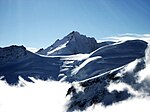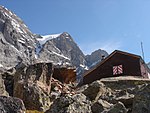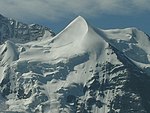Kranzberg (mountain)
Alpine three-thousandersBernese AlpsMountains of SwitzerlandMountains of ValaisMountains of the Alps ... and 1 more
Valais mountain stubs

The Kranzberg (3,742 m) is a mountain of the Bernese Alps, overlooking the Aletsch Glacier in the Swiss canton of Valais, close to the border with the canton of Bern. Its massif separates two glaciers: the Grosser Aletschfirn and the Jungfraufirn, both part of the Aletsch Glacier. A prominent unnamed secondary summit (3,666 m) is located south-east of the main peak. Debris accumulating on both sides of the mountain form one of the two important supraglacial moraines of the Aletsch Glacier (see picture on the top right of the article).
Excerpt from the Wikipedia article Kranzberg (mountain) (License: CC BY-SA 3.0, Authors, Images).Kranzberg (mountain)
Geographical coordinates (GPS) Address Website Nearby Places Show on map
Geographical coordinates (GPS)
| Latitude | Longitude |
|---|---|
| N 46.522083333333 ° | E 7.9811111111111 ° |
Address
Fieschertal
Wallis, Switzerland
Open on Google Maps











